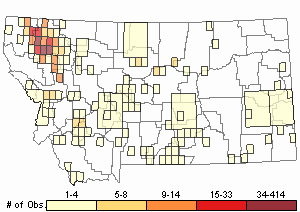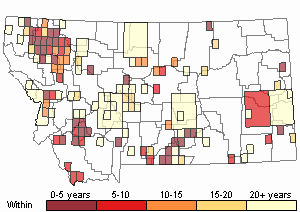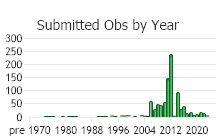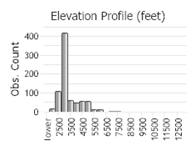View in other NatureServe Network Field Guides
NatureServe
Montana
Utah
Wyoming
Idaho
Wisconsin
British Columbia
South Carolina
Yukon
California
New York
Common Wormwood - Artemisia absinthium
Other Names:
Absinthe Wormwood, Absinthium, Wormwood Sage
General Description
Taprooted perennial. Stems erect, often branched, 40–80 cm. Herbage canescent. Leaves basal and cauline, petiolate; blades ovate, 2–10 cm long, 2 to 3 times pinnately divided into linear-lanceolate segments, reduced and less divided upward. Inflorescence leafy-paniculate; heads nodding. Involucre hemispheric, 2–3 mm high; phyllaries green, tomentose; receptacle villous. Disk flowers perfect and female, 40 to 70, glabrous to glandular; corolla 1–1.5 mm long. Achenes glabrous, ca. 1 mm long (
Lesica et al. 2012. Manual of Montana Vascular Plants. BRIT Press. Fort Worth, TX).
Diagnostic Characteristics
Among Artemisia, A. absinthium can be identified by the pistillate marginal flowers and perfect, fertile central flowers, a receptacle with long, woolly hairs, a coarse stem, and pinnately dissected leaves with oblong to linear-oblong leaf segments (Britton and Brown 1913, Fernald 1950).
Species Range
Montana Range
Range Descriptions

 Non-native
Non-native
Range Comments
Artemisia absinthium may be found from Newfoundland to Manitoba, as far north as Hudson's Bay, and south to Nova Scotia, New England, Pennsylvania, and New Jersey (Britton and Brown 1913, Fernald 1950). In the Midwest, it can be found in Ohio, Indiana, Wisconsin, and Minnesota (Fernald 1950). In the Great Plains, it is found in North Dakota, South Dakota, Montana, and the Prairie Provinces of Canada (Britton and Brown 1913, Fernald 1950, Molberg 1976, Wrage and Kinch 1973, Mitich 1975, Schroeder 1979). It is also known to occur in Nebraska and Kansas (McGregor et al. 1977).
Absinth sage is a native of Eurasia, the Middle East, and North Africa (Wrage and Kinch 1973, Mitich 1975). It was introduced to North America in the early part of the 19th century to be cultivated for medicinal and social uses (Mitich 1975), and was first reported outside cultivated gardens in 1841, along roadsides and on waste ground (Torrey and Gray 1841, Mitich 1975).
Observations in Montana Natural Heritage Program Database
Number of Observations: 1065
(Click on the following maps and charts to see full sized version)
Map Help and Descriptions
Relative Density

Recency



 (Observations spanning multiple months or years are excluded from time charts)
(Observations spanning multiple months or years are excluded from time charts)
Habitat
Management
Stewardship Responsibility
References
- Literature Cited AboveLegend:
 View Online Publication
View Online Publication Lesica, P., M.T. Lavin, and P.F. Stickney. 2012. Manual of Montana Vascular Plants. Fort Worth, TX: BRIT Press. viii + 771 p.
Lesica, P., M.T. Lavin, and P.F. Stickney. 2012. Manual of Montana Vascular Plants. Fort Worth, TX: BRIT Press. viii + 771 p.
- Additional ReferencesLegend:
 View Online Publication
View Online Publication
Do you know of a citation we're missing? Eggers, M.J.S. 2005. Riparian vegetation of the Montana Yellowstone and cattle grazing impacts thereon. M.Sc. Thesis. Montana State University, Bozeman, MT. 125 p.
Eggers, M.J.S. 2005. Riparian vegetation of the Montana Yellowstone and cattle grazing impacts thereon. M.Sc. Thesis. Montana State University, Bozeman, MT. 125 p. Lesica, P., M.T. Lavin, and P.F. Stickney. 2022. Manual of Montana Vascular Plants, Second Edition. Fort Worth, TX: BRIT Press. viii + 779 p.
Lesica, P., M.T. Lavin, and P.F. Stickney. 2022. Manual of Montana Vascular Plants, Second Edition. Fort Worth, TX: BRIT Press. viii + 779 p. Seipel, T.F. 2006. Plant species diversity in the sagebrush steppe of Montana. M.Sc. Thesis. Bozeman, MT: Montana State University. 87 p.
Seipel, T.F. 2006. Plant species diversity in the sagebrush steppe of Montana. M.Sc. Thesis. Bozeman, MT: Montana State University. 87 p.
- Web Search Engines for Articles on "Common Wormwood"





